It has generally been an accepted principle that intellectual property rights protect your actual interpretation rather than the idea in itself.
For example, if you paint a picture of an oak tree but invert the colours to make it look unusual you own the copyright in your picture so a third party cannot use it without your permission. However, there is nothing to stop someone else painting the same tree in inverted colours and using their own painting however they see fit. This is because you own the copyright of your picture rather than the idea behind it.
However, in October 2019 the Court of Appeal decided the case Julia Kogan v Nicholas Martin & others [2019] EWCA Civ 1645 and the Judges accepted that it is in theory possible for there to be some copyright protection in an idea itself.
This case related to the development of a screenplay. Ms Kogan had assisted Mr Martin in his initial drafting of the script for the Golden Globe nominated film, Florence Foster Jenkins. It was accepted that Ms Kogan had not been involved in the final draft of the script but in the earlier versions she had offered assistance in the terminology for stage directions, helpful criticism of dialogue and minor plot suggestions. It was further asserted that it was her idea in the first place to write a screenplay about the opera singer and she had introduced the idea to Mr Martin.
In the first instance hearing of the claim, Ms Kogan's assertion she should be recognised as a co-author of the screenplay was dismissed along with her claim for a share of the royalties. HHJ Hacon ruled that Ms Kogan's input was insufficient for her to be deemed to be a co-owner of the copyright as she had been offering practical advice rather than artistic.
Ms Kogan appealed and on appeal the Court determined that there should be re-trial of the case before a different Judge. The Court of Appeal found that if there was evidence of collaboration, then the Court needs to assess if there was sufficient involvement for there to be satisfaction of joint authorship. It was held, just because Ms Kogan had not contributed to the writing of the final draft of the screenplay, it did not mean that she could not be a joint author. They found that HHJ Hacon had dismissed Ms Kogan's contributions as "minor plot suggestions" when in the case of dramatic works in particular this should have been given more standing. Where a person's input is such they are deemed to be a collaborator in the development of an idea, that may be sufficient for them to be held to be a joint owner of the work.
The Court of Appeal felt the Judge at first instance had failed to make decisions on evidence as to whether the collaboration was sufficient. Therefore, they ordered a retrial of the facts. In making this Order the Court of Appeal strongly implied that it is possible for someone who has not been involved in the actual physical creation of the final work to still be held to be a co-owner of the copyright where their input in the idea was significant. Therefore, going forward there is certainly an argument that there can be intellectual property rights in developing a complex and detailed plot if that has assisted in creating the actual work.
In future cases it will be interesting to see if the Judges continue to extend copyright protection to give those involved in the development of ideas a share of ownership of stories, screenplays and scripts which are then turned into an actual work by another party. For those collaborating in the development of ideas it will be sensible to enter a written agreement at the outset as to the intention of ownership so that there is no scope for disagreement later.
The content of this article is intended to provide a general guide to the subject matter. Specialist advice should be sought about your specific circumstances.

